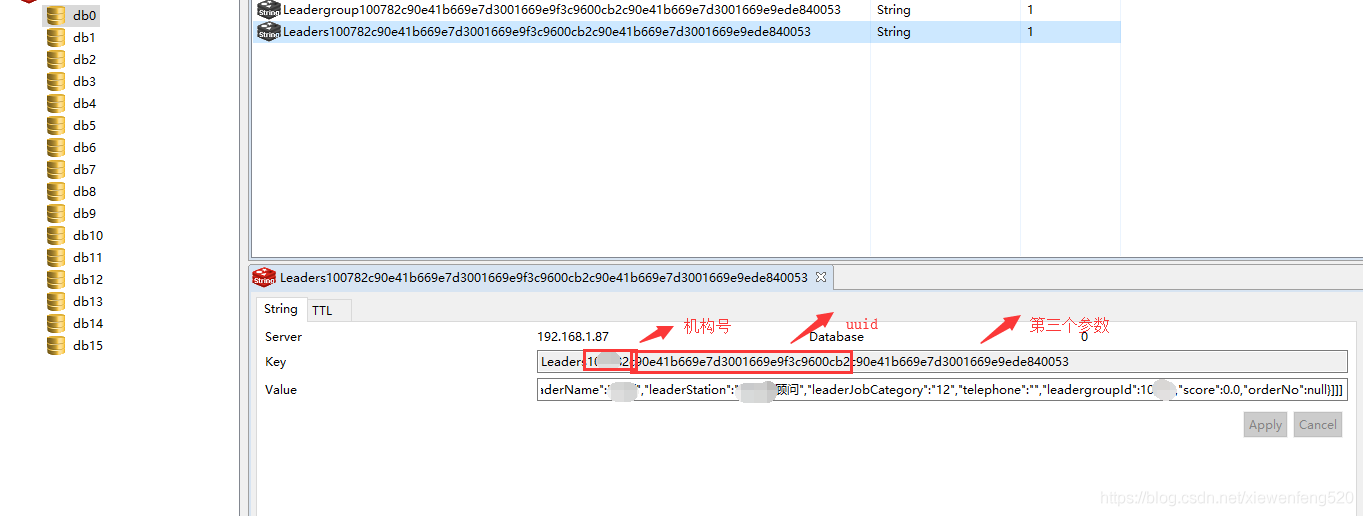您好,登录后才能下订单哦!
redis@Cacheable注解以及过期时间设置方式是什么,针对这个问题,这篇文章详细介绍了相对应的分析和解答,希望可以帮助更多想解决这个问题的小伙伴找到更简单易行的方法。
友情链接 手写redis @ Cacheable注解参数java对象作为键值
@Cacheable注解作用,将带有该注解方法的返回值存放到redis的的中;
使用方法在方法上使用@Cacheable(键=“测试+#P0 + P1#...”)
表示键值为测试+方法第一个参数+方法第二个参数,值为该方法的返回值。
以下源代码表示获取人员列表,Redis的中存放的关键值为'领袖'+ leaderGroupId + UUID + yearDetailId
@Override
@Cacheable(key="'leader'+#p0+#p1+#p2",value="leader")
public List<Leader> listLeaders(String leaderGroupId, String uuid, String yearDetailId) {
return sysIndexMapper.listLeaders(leaderGroupId, uuid, yearDetailId);
}等同于
@Override
public List<Leader> listLeaders(String leaderGroupId, String uuid, String yearDetailId) {
String key = "leader" + leaderGroupId + uuid + yearDetailId;
// 判断缓存是否存在redis中
boolean hasKey = redisUtil.hasKey(key);
if (hasKey) {
//如果存在 返还redis中的值
Object leadersList = redisUtil.get(key);
return (List<Leader>) leadersList;
} else {
List<Leader> leadersQuotaDetailList = sysIndexMapper.listLeaders(leaderGroupId, uuid, yearDetailId);
//将查询结果存放在redis中
redisUtil.set(key, leadersQuotaDetailList);
return leadersQuotaDetailList;
}
}说白了就是在原方法的前面判断的关键值是否存在的Redis的中,如果存在就取内存中的值,如果不存在就查询数据库,将查询结果存放在Redis的的中。
使用代理模式,在方法执行前和执行后可以添加其他处理程序,本文采用springAOP +注解方式。
集成redis,封装Redis工具类
原版本不支持 过期时间 设置,本文将实现
缓存配置类RedisConfig
package com.huajie.config;
import org.springframework.beans.factory.annotation.Value;
import org.springframework.cache.CacheManager;
import org.springframework.cache.annotation.CachingConfigurerSupport;
import org.springframework.cache.annotation.EnableCaching;
import org.springframework.cache.interceptor.KeyGenerator;
import org.springframework.context.annotation.Bean;
import org.springframework.context.annotation.Configuration;
import org.springframework.data.redis.cache.RedisCacheManager;
import org.springframework.data.redis.connection.RedisConnectionFactory;
import org.springframework.data.redis.core.RedisTemplate;
import org.springframework.data.redis.core.StringRedisTemplate;
import org.springframework.data.redis.serializer.Jackson2JsonRedisSerializer;
import org.springframework.data.redis.serializer.StringRedisSerializer;
import com.fasterxml.jackson.annotation.JsonAutoDetect;
import com.fasterxml.jackson.annotation.PropertyAccessor;
import com.fasterxml.jackson.databind.ObjectMapper;
/**
* Redis缓存配置类
*/
@Configuration
@EnableCaching
public class RedisConfig extends CachingConfigurerSupport {
@Value("${spring.redis.host}")
private String host;
@Value("${spring.redis.port}")
private int port;
@Value("${spring.redis.timeout}")
private int timeout;
// 自定义缓存key生成策略
@Bean
public KeyGenerator keyGenerator() {
return new KeyGenerator() {
@Override
public Object generate(Object target, java.lang.reflect.Method method, Object... params) {
StringBuffer sb = new StringBuffer();
sb.append(target.getClass().getName());
sb.append(method.getName());
for (Object obj : params) {
sb.append(obj.toString());
}
return sb.toString();
}
};
}
// 缓存管理器
@Bean
public CacheManager cacheManager(@SuppressWarnings("rawtypes") RedisTemplate redisTemplate) {
RedisCacheManager cacheManager = new RedisCacheManager(redisTemplate);
// 设置缓存过期时间
cacheManager.setDefaultExpiration(10000);
return cacheManager;
}
@Bean
public RedisTemplate<String, Object> redisTemplate(RedisConnectionFactory factory) {
RedisTemplate<String, Object> template = new RedisTemplate<String, Object>();
template.setConnectionFactory(factory);
Jackson2JsonRedisSerializer jackson2JsonRedisSerializer = new Jackson2JsonRedisSerializer(Object.class);
ObjectMapper om = new ObjectMapper();
om.setVisibility(PropertyAccessor.ALL, JsonAutoDetect.Visibility.ANY);
om.enableDefaultTyping(ObjectMapper.DefaultTyping.NON_FINAL);
jackson2JsonRedisSerializer.setObjectMapper(om);
StringRedisSerializer stringRedisSerializer = new StringRedisSerializer();
// key采用String的序列化方式
template.setKeySerializer(stringRedisSerializer);
// hash的key也采用String的序列化方式
template.setHashKeySerializer(stringRedisSerializer);
// value序列化方式采用jackson
template.setValueSerializer(jackson2JsonRedisSerializer);
// hash的value序列化方式采用jackson
template.setHashValueSerializer(jackson2JsonRedisSerializer);
template.afterPropertiesSet();
return template;
}
private void setSerializer(StringRedisTemplate template) {
@SuppressWarnings({ "rawtypes", "unchecked" })
Jackson2JsonRedisSerializer jackson2JsonRedisSerializer = new Jackson2JsonRedisSerializer(Object.class);
ObjectMapper om = new ObjectMapper();
om.setVisibility(PropertyAccessor.ALL, JsonAutoDetect.Visibility.ANY);
om.enableDefaultTyping(ObjectMapper.DefaultTyping.NON_FINAL);
jackson2JsonRedisSerializer.setObjectMapper(om);
template.setValueSerializer(jackson2JsonRedisSerializer);
}
}Redis的依赖引入,配置文件,工具类RedisUtil,网上几个版本都类似,本文参考以下版本传送门
https://www.yisu.com/article/233562.htm
准备工作做好之后开始正式编写注解@Cacheable nextkey()用做二级缓存本文中不会用到
nextKey用法详情> 设计模式(实战) - 责任链模式 <
创建的Java的注解@ExtCacheable
package com.huajie.annotation;
import java.lang.annotation.ElementType;
import java.lang.annotation.Retention;
import java.lang.annotation.RetentionPolicy;
import java.lang.annotation.Target;
@Target({ ElementType.METHOD })
@Retention(RetentionPolicy.RUNTIME)
public @interface ExtCacheable {
String key() default "";
String nextKey() default "";
int expireTime() default 1800;//30分钟
}SpringAop切面CacheableAspect
package com.huajie.aspect;
import java.lang.reflect.Method;
import java.util.ArrayList;
import java.util.List;
import org.aspectj.lang.ProceedingJoinPoint;
import org.aspectj.lang.annotation.Around;
import org.aspectj.lang.annotation.Aspect;
import org.aspectj.lang.annotation.Pointcut;
import org.aspectj.lang.reflect.MethodSignature;
import org.springframework.beans.factory.annotation.Autowired;
import org.springframework.stereotype.Component;
import com.huajie.annotation.ExtCacheable;
import com.huajie.utils.RedisUtil;
/**
* redis缓存处理
* 不适用与内部方法调用(this.)或者private
*/
@Component
@Aspect
public class CacheableAspect {
@Autowired
private RedisUtil redisUtil;
@Pointcut("@annotation(com.huajie.annotation.ExtCacheable)")
public void annotationPointcut() {
}
@Around("annotationPointcut()")
public Object doAround(ProceedingJoinPoint joinPoint) throws Throwable {
// 获得当前访问的class
Class<?> className = joinPoint.getTarget().getClass();
// 获得访问的方法名
String methodName = joinPoint.getSignature().getName();
// 得到方法的参数的类型
Class<?>[] argClass = ((MethodSignature) joinPoint.getSignature()).getParameterTypes();
Object[] args = joinPoint.getArgs();
String key = "";
int expireTime = 1800;
try {
// 得到访问的方法对象
Method method = className.getMethod(methodName, argClass);
method.setAccessible(true);
// 判断是否存在@ExtCacheable注解
if (method.isAnnotationPresent(ExtCacheable.class)) {
ExtCacheable annotation = method.getAnnotation(ExtCacheable.class);
key = getRedisKey(args,annotation);
expireTime = getExpireTime(annotation);
}
} catch (Exception e) {
throw new RuntimeException("redis缓存注解参数异常", e);
}
// 获取缓存是否存在
boolean hasKey = redisUtil.hasKey(key);
if (hasKey) {
return redisUtil.get(key);
} else {
//执行原方法(java反射执行method获取结果)
Object res = joinPoint.proceed();
//设置缓存
redisUtil.set(key, res);
//设置过期时间
redisUtil.expire(key, expireTime);
return res;
}
}
private int getExpireTime(ExtCacheable annotation) {
return annotation.expireTime();
}
private String getRedisKey(Object[] args,ExtCacheable annotation) {
String primalKey = annotation.key();
//获取#p0...集合
List<String> keyList = getKeyParsList(primalKey);
for (String keyName : keyList) {
int keyIndex = Integer.parseInt(keyName.toLowerCase().replace("#p", ""));
Object parValue = args[keyIndex];
primalKey = primalKey.replace(keyName, String.valueOf(parValue));
}
return primalKey.replace("+","").replace("'","");
}
// 获取key中#p0中的参数名称
private static List<String> getKeyParsList(String key) {
List<String> ListPar = new ArrayList<String>();
if (key.indexOf("#") >= 0) {
int plusIndex = key.substring(key.indexOf("#")).indexOf("+");
int indexNext = 0;
String parName = "";
int indexPre = key.indexOf("#");
if(plusIndex>0){
indexNext = key.indexOf("#") + key.substring(key.indexOf("#")).indexOf("+");
parName = key.substring(indexPre, indexNext);
}else{
parName = key.substring(indexPre);
}
ListPar.add(parName.trim());
key = key.substring(indexNext + 1);
if (key.indexOf("#") >= 0) {
ListPar.addAll(getKeyParsList(key));
}
}
return ListPar;
}
}业务模块使用方法
@Override
@ExtCacheable(key = "Leaders+#p0+#p1+#p2")
// 手机端获取领导人员列表
public List<Leader> listLeaders(String leaderGroupId, String uuid, String yearDetailId) {
List<Leader> leadersQuotaDetailList = sysIndexMapper.listLeaders(leaderGroupId, uuid, yearDetailId);
return leadersQuotaDetailList;
}业务模块过期时间使用方法,5分钟过期
@Override
@ExtCacheable(key = "mobileCacheFlag", expireTime = 60 * 5)
public int cacheFlag() {
int mobileCacheFlag = 1;
mobileCacheFlag = sysIndexMapper.cacheFlag();
return mobileCacheFlag;
}Redis的的截图

关于redis@Cacheable注解以及过期时间设置方式是什么问题的解答就分享到这里了,希望以上内容可以对大家有一定的帮助,如果你还有很多疑惑没有解开,可以关注亿速云行业资讯频道了解更多相关知识。
免责声明:本站发布的内容(图片、视频和文字)以原创、转载和分享为主,文章观点不代表本网站立场,如果涉及侵权请联系站长邮箱:is@yisu.com进行举报,并提供相关证据,一经查实,将立刻删除涉嫌侵权内容。